Media Included
- Pride in Alaska - Part 1 - Pride. Strength, Courage, and Diversity in the National Park Service in Alaska - Part 1 of a series of 3 videos created by the Alaska National Park Service. During specific months of the year, our Nation recognizes, celebrates, and honors the rich diversity of our people. To celebrate the June observance of Lesbian Gay Bisexual Transgender and Queer History in America, our employees share stories of their own early struggles and encouragement for others.
- Pride in Alaska - Part 2 - Pride. Strength, Courage, and Diversity in the National Park Service in Alaska - Part 2 of a series of 3 videos created by the Alaska National Park Service. During specific months of the year, our Nation recognizes, celebrates, and honors the rich diversity of our people. To celebrate the June observance of Lesbian Gay Bisexual Transgender and Queer History in America, our employees share stories of their own early struggles and encouragement for others.
- Pride in Alaska - Part 3 - Pride. Strength, Courage, and Diversity in the National Park Service in Alaska - Part 3 Part 3 of a series of 3 videos created by the Alaska National Park Service. During specific months of the year, our Nation recognizes, celebrates, and honors the rich diversity of our people. To celebrate the June observance of Lesbian Gay Bisexual Transgender and Queer History in America, our employees share stories of their own early struggles and encouragement for others.
A nation where... all of us are free to live and love as we see fit. President Barack Obama - LGBT Pride Proclamation 2012
Pride. Strength, Courage, and Diversity
During specific months of the year, our Nation recognizes, celebrates, and honors the rich diversity of our people. In 2012, Denali National Park Ranger, Timothy Rains, proposed an idea to celebrate the June observance of Lesbian, Gay, Bisexual, Transgender, and Queer History of Americans. He was inspired by the "It Gets Better" project video in which LGBTQ DOI employees support and reassure LGBTQ youth by providing stories of their own early struggles and encouragement that it does indeed get better. Tim wanted to produce a video where he‘d share the story about his experience working for the National Park Service and how it helped him make peace with his identity, as well as provide an opportunity for fellow LGBTQ employees to share their stories.
Tim described the response to his project idea as "quick and supportive" from both his supervisor, Ingrid Nixon, Chief Interpretation and Superintendent, Paul Anderson. From that point, the Regional Office took this small flicker of an idea and gave it what it needed to flourish. For the first time in Alaska, " ...they provided a way for those of us working in the remote areas of the state an opportunity to connect and create that strong sense of community through a shared goal... "
The Project Takes Form
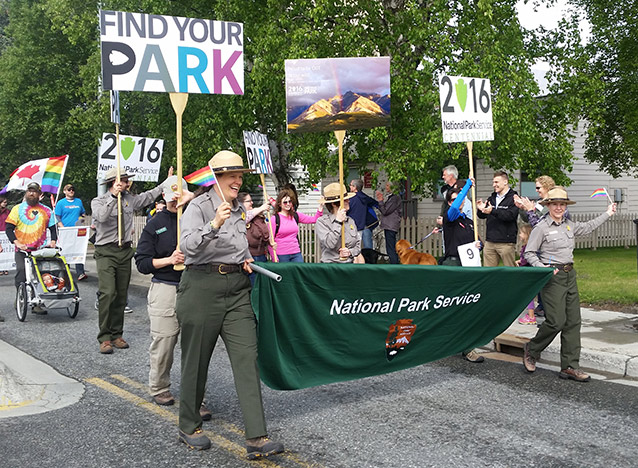
NPS Photo.
A series of videos became the vision. Originally, we didn’t want to frame the experience of our employees, but rather provide them with a blank slate to share their stories from their perspective. We wanted our volunteers to share what they felt was an important message in their own words.
We quickly learned that without structure, employees struggled to talk openly about their experiences. We provided a few questions to help our employees begin the conversation. We thank our 13 volunteers for sharing.
There are three videos in this series. We thank our employees for having the courage to share their stories.
The Response
In discussions with the Alaska Regional Office, " ...they quickly realized this project was larger than the story I wanted to tell..." Tim said. Within just a couple of days of the project announcement, Tim received 13 volunteers from several parks across the state. During pre- and post-production dialogues, several of the employees expressed what it meant to participate in the project. Their narrations are positive, encouraging and hopeful, yet some admit feelings of caution.
Below are just a few reflections:
Dael Devenport
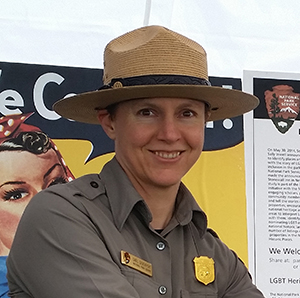
NPS Photo
Dael Devenport – archeologist, Alaska Regional Office – The opportunity to participate in this project has meant a lot to me. I think it will take me a while to realize all of the repercussions of participating, but one immediate effect I have noticed is that I can relax more at work. It's like a weight has been lifted off my shoulders that I didn’t realize I was carrying. I'm no longer worried about being outed and fired. And I can talk more openly to my coworkers, for example, if someone asks me what I am doing this weekend, I don't have to try to avoid mentioning my partner. I also now realize that there are several other gay people that I work with and that, while there may not be a lot of us, we are everywhere, from Eagle to Gustavus. It makes me really proud to work for an organization that is not ashamed of or afraid of its employees or people who are different. It takes courage to stand up for a group of people that is denigrated by a large segment of the population. The Park Service could just have easily taken the stand that since they serve the public and because a significant percentage of the public does not approve of gay people, the Park Service would choose to avoid controversy. But instead, they stood up, stepped out and chose to ’celebrate and value individual differences’. Thank you!
Timothy Rains
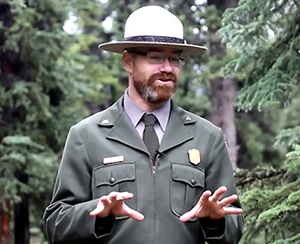
NPS Photo
Timothy Rains – interpretive park ranger, Denali National Park and Preserve – I learned that I was not alone. As the project developed, we talked about the issues that we all faced. Then we shared our stories of what it meant to be a National Park Ranger in Alaska and how we cope with our identity. That, in itself, was an unexpected gift.
Pat Sanders
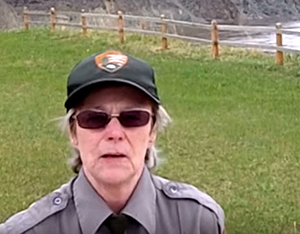
NPS Photo.
Pat Sanders – park ranger interpretation, Yukon-Charley Rivers National Park and Preserve– It was difficult, upon reflection, to place myself in a position knowing that I was laying it on the line to be "judged by my peers. I want the same thing that every human wants and should be entitled to have, equality. If you must judge me, judge me for how I live my life, who I positively impact and, if I truly care about others but, not because I am labeled as a lesbian. I am human and like all humans, I have flaws but, I will never have the flaw of labeling or judging or oppressing anyone. I don't want or expect to be treated differently than my fellow human but, I do crave to be equal and treated with respect, if I have earned respect. Am I worried about the ramifications? Yes. Am I concerned that I have potentially placed myself in a precarious situation? Yes. Do I care? Yes. Will I continue to live with a positive attitude and do the best job I can? You bet.
Sarah Venator
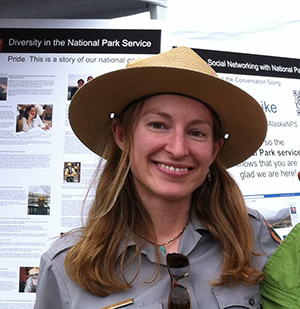
NPS Photo
Sarah Venator – geologist, Alaska Regional Office –Here in Alaska, as well as throughout half of the United States, LGBT employees are not guaranteed protection from discrimination. As an employee of the National Park Service I feel very lucky that I have been judged on the merit of my work, not the gender of my partner.
When I heard that the Alaska Region was participating in outreach events for LGBT Pride Month, I was thrilled. Of course, I already knew that the National Park Service does not discriminate. But not to discriminate is to refrain from taking a negative action. To reach out to a community and say to it that the National Park Service tells your story too, is to take a very affirming action.
The video project was showcased at the June 2012 Anchorage PrideFest. The people who attended the National Park Service booth seemed surprised to see us there, but glad. People shared stories about how important the national parks have been to their lives. That, to me, was a welcome sign that the audience at the festival did receive our message of inclusivity.
People use phrases like "Accepting," or "Tolerant," to describe workplaces free from discrimination. This project showed me for the first time how powerful a truly accepting and welcoming workplace could be.
Sierra Willoughby
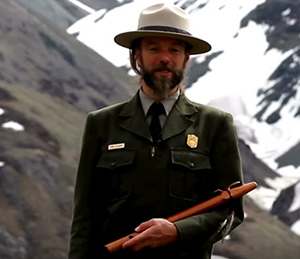
NPS Photo.
Sierra Willoughby – interpretive park ranger, Denali National Park and Preserve – When the Alaska region put out the word for LGBT folks to submit a video to tell their story, I was enthusiastic to be able to tell my story. I am an interpretive ranger and it’s my job to tell the stories that help people relate themselves to the culture and nature of our national parks. As a gay man who has been part of the LGBT community for two decades, it has been my experience that the LGBT culture is centered around larger urban centers, away from our larger outdoor nature themed parks. Being able to tell my story as an 11 year seasonal interpretive ranger, who has worked at Mount Rainier, Yosemite, Glacier Bay, Santa Monica Mountains, and Denali is a way for me to let others know that working and visiting in wild parks is something that is friendly and enjoyable for LGBT folks. It is my hope that our video project here for the National Park Service shows how supportive we are as an agency to having a diverse work force, and that as a public trust, national parks are for people of all threads of the rainbow of diversity that makes up society including lesbian, gay, bisexual, transgender (and questioning) folks. LGBT folks still do not have equal rights in society, and having our national parks being a showcase for inclusivity is healing and a good policy so that parks are relevant and protected by our future generations. In addition to showing our diversity and acceptance as an agency, I also wanted to let other LGBT folks know that wilderness and nature found in wild lands such as our national parks, are healing sanctuaries where we can feel accepted and rejuvenated when we spend time alone in a natural setting. For many LGBT folks, discrimination, bullying, and emotional abuse have been part of their life experience, and having national parks available for healing and rejuvenation is a wonderful thing!
Rebecca Shaffer
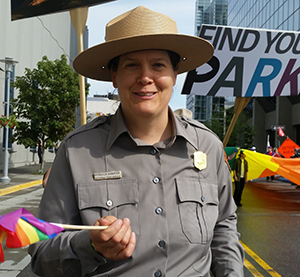
NPS Photo.
Rebecca Shaffer – Intern Architect, Alaska Regional Office – I did try to make my video apolitical knowing that it might be viewed under the umbrella of my workplace which on the face of it seems larger than one person’s experience. What is one ’s story in terms of the National Park Service or the United States of America? In watching other videos, I was glad to know about the experience of others. Every story is unique and I found them all to be like gold, inseparable from the whole experience of the many hundreds of National Park Service employees and National Park visitors. In reflecting on the process of making the video, seeing the other videos, and talking about them, I am so glad we could do this! People’s stories are very important, at least, I realized in surprise how important they are, and the telling of them is, to me.
The day after I received the email from Tim asking for videos, I was scheduled to go to Lake Clark National Park and Preserve which entails flying through a narrow mountain pass, Lake Clark Pass -- gorgeous, but frequently turbulent with low visibility. In preparation for flight, the pilot tells you specifically where the emergency locator beacon is, fire extinguisher, first aid kit, and the location of emergency supplies, like flares and water, in the airplane’s tail. I love flying. If I didn’t feel safe, I would have a good reason and something would have to change before I went – as spelled out in the passenger bill of rights. After a couple of turbulent shakes and drops in the air, I remembered the assignment to make the video, and it occurred to me in this setting how ridiculous discrimination seems, here and everywhere else. I pulled out my camera and starting filming with the abiding thought, if we were suddenly marooned in this landscape, how much would it matter whether any of us were gay or straight? When my partner Tessa drops me off at Merrill Field's runway, I consider the chance, however small, of something happening. She's a realist so it’s not heartbreaking to talk with her about it. I can tell she thinks about it. I'm sure it shows that I have just a little, perhaps healthy amount, of fear. She knows that I would never trade this risk for not going and she tells me to she would love me all the way to the ground and whatever came after. This is one of the moments when I feel so lucky to have her in my life. I feel the certainty of being me, and for a moment the goodness of life seems palpable.
Last updated: October 23, 2021
